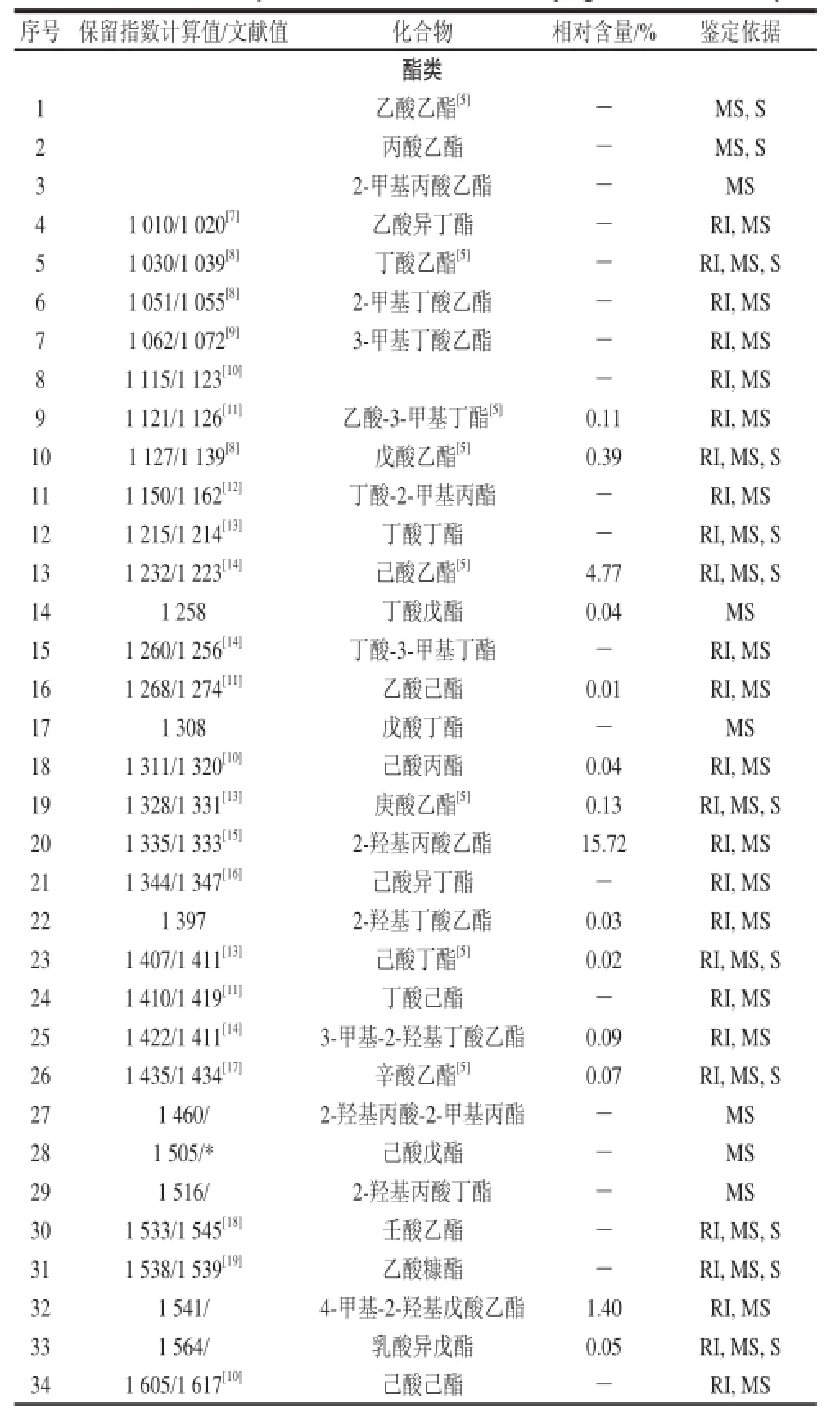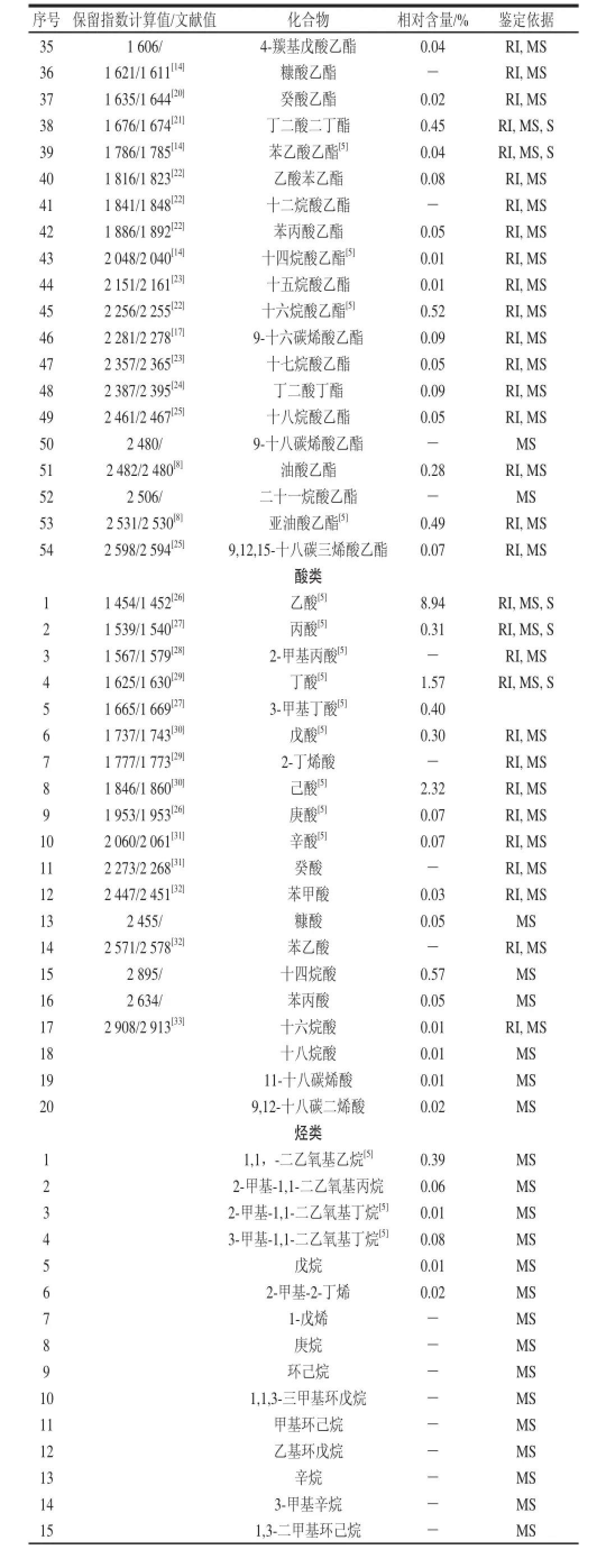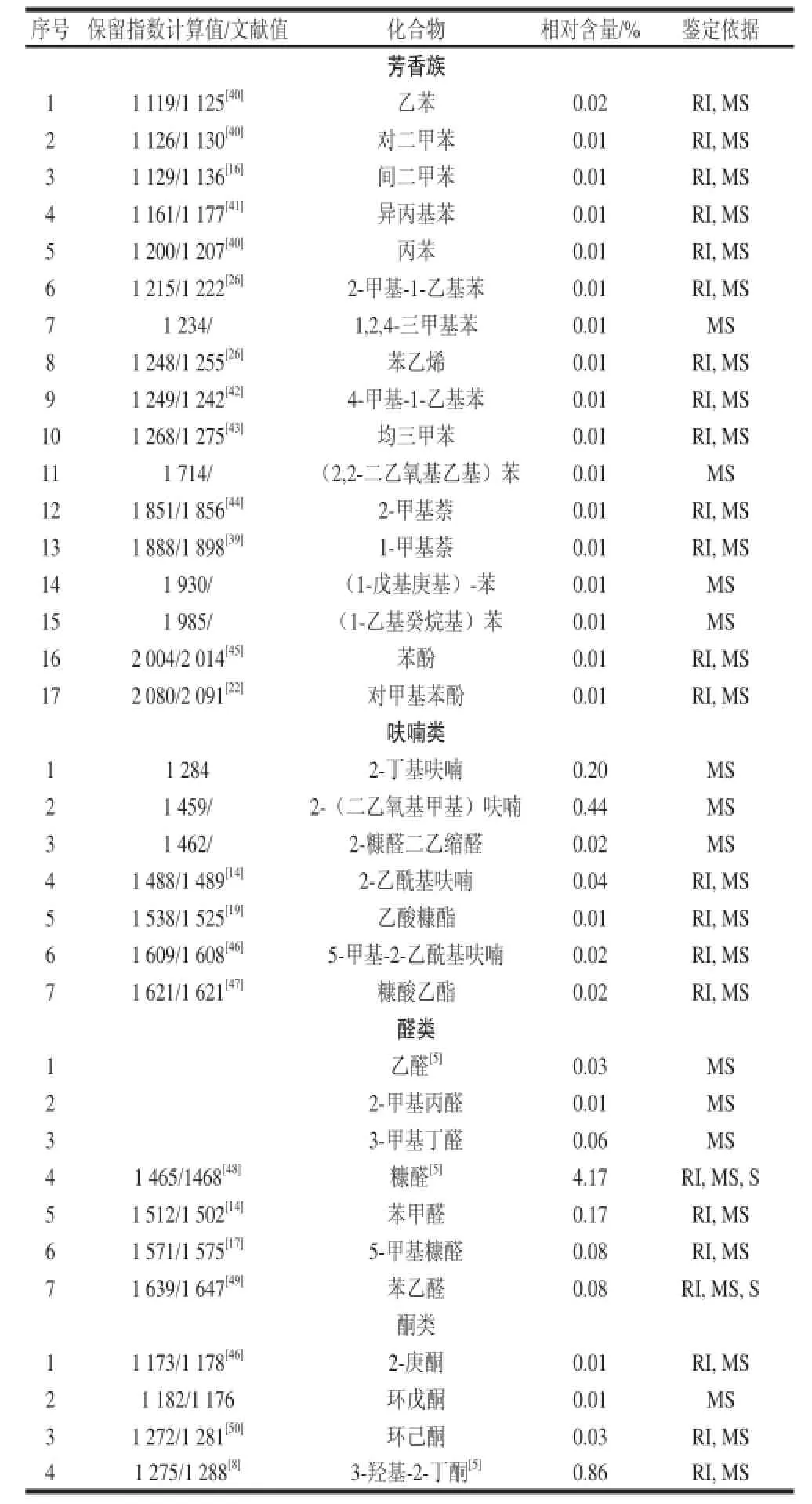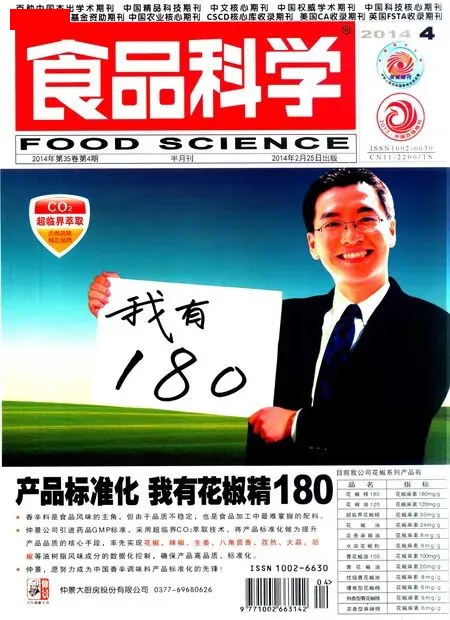扳倒井芝麻香型白酒香成分分析
2014-01-18赵纪文张锋国黄明泉孙宝国郑福平孙金沅
郑 杨,赵纪文, 张锋国,黄明泉,*,孙宝国,郑福平,孙金沅
(1.北京工商大学 北京市食品风味化学重点实验室,食品添加剂与配料北京高校工程研究中心,北京 100048;2.山东扳倒井集团技术中心,山东 高青 256300)
扳倒井芝麻香型白酒香成分分析
郑 杨1,赵纪文2, 张锋国2,黄明泉1,*,孙宝国1,郑福平1,孙金沅1
(1.北京工商大学 北京市食品风味化学重点实验室,食品添加剂与配料北京高校工程研究中心,北京 100048;2.山东扳倒井集团技术中心,山东 高青 256300)
采用液-液萃取法提取,通过气相色谱-质谱联用技术分析芝麻香型白酒中的香气成分,并通过标准品、NIST 11谱库检索、保留指数3种方法进行定性分析。结果表明:扳倒井芝麻香型白酒中共鉴定出挥发性成分179种,包括酯类54种、烃类51种、酸类20种、醇类19种、芳香族化合物17种、醛类7种、呋喃类7种、酮类4种。其中相对含量较高的有2-羟基丙酸乙酯(15.72%)、3-甲基-1-丁醇(11.20%)、乙酸(8.94%)、己酸乙酯(4.77%)、糠醛(4.17%)。
芝麻香型白酒;液-液萃取;气相色谱-质谱联用;香气成分
白酒是以粮谷为原料,以酒曲为糖化发酵剂,经蒸煮、糖化发酵、蒸馏、贮存、勾兑而成。中国传统的蒸馏酒,与白兰地、威士忌、伏特加、朗姆酒和金酒并列为世界上著名的六大蒸馏酒[1]。芝麻香型白酒属于建国后的创新香型酒之一,是由酱香型白酒派生出来的。芝麻香型白酒既有清香型白酒的清净典雅,又具有浓香型白酒的绵柔丰满,还具有酱香型酒的幽雅细腻,综合感官有焙烤芝麻的特殊香味[2]。目前在山东、江苏、河南等地有几十家白酒企业生产芝麻香型白酒。
我国20世纪60年代确定芝麻香型白酒,80年代开始研究芝麻香型白酒香味组成。较于其他香型的白酒,芝麻香型白酒香味成分等方面的研究较为落后。胡国栋[3]利用动态顶空吸附、直接进样法检出50种化合物,并结合芝麻香油中定性成分推测景芝白干的吡嗪类及其他杂环类化合物对其香气具有重要意义。1994年胡国栋等[4]又发现有2个组分峰为芝麻香型白酒所特有,其中之一经分析鉴定为3-甲硫基丙醇。武金华等[5]对生力源品牌的芝麻香型白酒成分进行分析,检出50种化合物,其中含量较高的有乙酸乙酯(2.24 g/L)、乳酸乙酯(2.05 g/L)、己酸乙酯(0.95 g/L)。张媛媛等[6]利用固相微萃取技术对扳倒井芝麻香型白酒中的含硫化合物进行了分析,鉴定出4种含硫化合物(3-甲硫基丙酸乙酯、3-甲硫基丙醇、甲硫基乙酸乙酯、二甲基三硫),但目前对扳倒井芝麻香型白酒的其他挥发性成分的研究还未见报道。
本研究主要利用液-液萃取技术结合气相色谱-质谱(gas chromatography-mass spectrometry,GC-MS),对扳倒井芝麻香型原浆白酒中的挥发性成分进行全面分析。
1 材料与方法
1.1 材料与试剂
酒样 山东扳倒井酒业有限公司。
二氯甲烷、无水硫酸钠(均为分析纯) 国药集团化学试剂有限公司;丁酸乙酯、丁酸丁酯、己酸乙酯、庚酸乙酯、己酸丁酯、丁二酸二丁酯、辛酸乙酯、壬酸乙酯、苯乙酸乙酯、正丙醇、正丁醇、正戊醇、糠醇、糠醛、苯乙醛、正构烷烃(C6~C30)(均为色谱纯) 北京百灵威科技有限公司;高纯氦气(99.999%) 北京北分气体工业有限公司。
1.2 仪器与设备
RE-52AA旋转蒸发仪 上海亚荣生化仪器厂;SL-N电子天平 上海民桥精密科学仪器有限公司;7890N-5975c气相色谱-质谱联用仪、10 μL微量进样器 美国Agilent公司;N-Evap系列氮吹仪 上海思伯明仪器设备有限公司;连续萃取装置 北京汇海科技有限公司。
1.3 方法
1.3.1 液-液连续萃取
取40 mL酒样、250 mL重蒸二氯甲烷于连续萃取装置中萃取10 h,萃取液加适量无水硫酸钠干燥,密封,-20 ℃静置过夜后过滤,滤液用旋转蒸发器浓缩至1.0 mL,氮吹浓缩至0.5 mL,待GC-MS分析。
1.3.2 色谱条件
色谱柱:FFAP毛细管柱(60m×0.25mm,0.25 μm);载气He(99.999%);恒流,柱流速1.0 mL/min;分流比20∶1;进样体积1.0 μL;进样口温度250 ℃;升温程序:初始35 ℃,10 ℃/min升至50 ℃,保持20 min,以1 ℃/min升至70 ℃,保持10 min,再以3 ℃/min升至250 ℃,保持5 min;传输管线温度280 ℃。
1.3.3 质谱条件
电子电离离子源;电子能量70 eV;离子源温度230 ℃;四极杆温度150 ℃;溶剂延迟3.0 min;全扫描模式;质量扫描范围m/z 29~450。
1.4 定性分析
用标准品、NIST 11谱库检索,并结合保留指数、参考文献及相关网站(http://www.odour.org.uk)等共同进行定性。保留指数(retention index,RI)计算公式:

式中:n和n+1分别为未知物流出前、后正构烷烃碳原子数;tRn和tRn+1分别为相应正构烷烃的保留时间/min;tR为未知物在气相色谱中的保留时间(tRn<tR<tRn+1)/min。
2 结果与分析
通过GC-MS对扳倒井白酒挥发性成分进行分析,同时用标准品、谱库检索和保留指数等定性方法进行鉴定,其总离子流图见图1,鉴定结果见表1。

图1 扳倒井芝麻香型白酒挥发性成分总离子流图Fig.1 Total ion current chromatogram of volatile compounds in Bandaojing sesame-flavor liquor

表1 扳倒井芝麻香型白酒香气成分定性结果Table 1 Aroma compounds identified in Bandaojing sesame-flavor liquor

续表1

续表1

续表1
从表1可以看出,扳倒井芝麻香型白酒中主要挥发性成分有192种,包括酯类54种、醇类19种、酸类20种、醛类7种、烃类51种、芳香族化合物17种、酮类4种、呋喃类7种、含硫化合物7种、含氮化合物6种。其中相对含量较高的有2-羟基丙酸乙酯(15.72%)、3-甲基-1-丁醇(11.20%)、乙酸(8.94%)、己酸乙酯(4.77%)、糠醛(4.17%)。与武金华等[5]的结果比较发现:其中41种化合物已检出,多为酯和醇类;胡国栋等[4]认为大多数杂环化合物和含硫化合物均具有强烈的芳香作用,它们与其他组分一起构成了芝麻油所特有的香气,因此对该类化合物需进一步研究。
芝麻香型白酒兼具浓香型、酱香型、清香型白酒的特点[2],化合物的分析中也证明了这一点:扳倒井芝麻香白酒包含以上3大香型白酒的所有主体成分,但在含量上差异较大,扳倒井芝麻香白酒含有相对丰富的乳酸乙酯和己酸乙酯,其他酯类含量相对较少,这也说明芝麻香型白酒在风味特征上有别于浓、酱、清香型白酒。
除杂环化合物和含硫化合物外,酒中其他类化合物也能挥发出一定的香气。例如酮类化 合物中的2-庚酮具有水果、奶油、青香香气,3-羟基-2-丁酮具有强烈的奶油、脂肪、白脱样香气,高度稀释后有令人愉快的奶香气;正辛醇具有青香、柑橘、甜橙香气;苯乙醇具有甜的、面包、玫瑰香气;C6~C12饱和脂肪族醛稀释后具有令人愉快的香气;苯甲醛具有杏仁、果香、坚果香气;苯乙醛具有甜的、青香、花香巧克力香气;羧酸广泛存在自然界中,不但可以作为食品的调味剂,也是合成香料的重要原料;正戊酸具有奶酪、酸奶水果香气;庚酸具有甜的、水果、奶酪的香气;苯乙酸则具有烟草、酚香、巧克力香气;本实验所得酯类大都具有一定的香气,乙酸乙酯具有愉快的菠萝果香,同时还有酒样的味道;乙酸-2-甲基丁酯具有强烈的如香蕉、生梨、苹果般的水果香气;苯乙酸乙酯具有花香、酚香,常用于中档或低档的玫瑰、橙花等日用香精。
3 结 论
扳倒井芝麻香型白酒中共检测出179种主要挥发性成分,包括酯类54种、烃类51种、酸类20种、醇类19种、芳香族化合物17种、醛类7种、呋喃类7种、酮类4种。
要想稳定地产出风格典型的芝麻香酒,首先需要有科学合理的生产工艺,并研究其呈香、呈味机理,分析其特征香味成分。特征香味成分的确认是研究芝麻香型白酒的基础和核心。GB/T 20824—2007《芝麻香型白酒》中,指出3-甲硫基丙醇为该香型白酒的特征成分,但单一的特征成分难以代表芝麻香型白酒的特征香味,所以需深入研究芝麻香型白酒的香气成分,以期得到风格稳定的芝麻香型白酒,推动生产酒企的发展。
[1] 肖冬光. 白酒生产技术[M]. 北京: 化学工业出版社, 2012: 3.
[2] 黄业立, 张彬, 武金华. 试论芝麻香型白酒[J]. 酿酒科技, 2007, 28(7): 116-119.
[3] 胡国栋. 景芝白干特征香味组份的研究[J]. 酿酒, 1992, 19(1): 83-88.
[4] 胡国栋, 陆久瑞. 芝麻香型白酒特征组分的分析研究[J]. 酿酒科技, 1994, 15(4): 75-77.
[5] 武金华, 孙启栋, 姜淑芬, 等. 芝麻香型白酒成分的分析及探讨[J].酿酒科技, 2009, 30(6): 65-69.
[6] 张媛媛, 孙金沅, 孙宝国, 等. 扳倒井芝麻香型白酒中含硫风味成分的分析[J]. 中国食品学报, 2012, 12(12): 173-179.
[7] MATTHEIS J P, FAN Xuetong, ARGENTA L C, et al. Interactive responses of gala apple fruit volatile production to controlled atmosphere and chemical inhibition of ethylene action[J]. Journal of Agricultural and Food Chemistry, 2005, 53(11): 4510-4516.
[8] CHUNG H Y. Volatile flavor components in red fermented soybean (Glycine max) curds[J]. Journal of Agricultural and Food Chemistry, 2000, 48(5): 1803-1809.
[9] GURBUZ O, ROUSEFF J M, ROUSEFF R L. Comparison of aroma volatiles in commercial merlot and cabernet sauvignon wines using gas chromatography-olfactometry and gas chromatography-mass spectrometry[J]. Journal of Agricultural and Food Chemistry, 2006, 54(11): 3990-3996.
[10] HAYATA Y, SAKAMOTO T. Analysis of aromatic volatile compounds in ‘Miyabi’ melon (Cucumis melo L.) using the Porapak Q column[J]. Journal of the Japanese Society for Horticultural Science, 2002, 71(4): 517-525.
[11] TATSUKA K, SUEKANE S, SAKAI Y, et al. Volatile constituents of kiwi fruit flowers: simultaneous distillation and extraction versus headspace sampling[J]. Journal of Agricultural and Food Chemistry, 1990, 38(12): 2176-2180.
[12] KOURKOUTAS D, ELMORE J S, MOTTRAM D S. Comparison of the volatile compositions and flavour properties of cantaloupe, Galia and honeydew muskmelons[J]. Food Chemistry, 2006, 97(1): 95-102.
[13] VERZERA A, ZIINO M, CONDURSO C, et al. Solid-phase microextraction and gas chromatography-mass spectrometry for rapid characterization of semi-hard cheeses[J]. Analytical and Bioanalytical Chemistry, 2004, 380(7): 930-936.
[14] FERRARI G, LABLANQUIE O, CANTAGREL R, et al. Determination of key odorant compounds in freshly distilled cognac using GC-O, GC-MS, and sensory evaluation[J]. Journal of Agricultural and Food Chemistry, 2004, 52(18): 5670-5676.
[15] PINO J A, MARBOT R, VAZQUEZ C. Characterization of volatiles in strawberry guava (Psidium cattleianum Sabine) fruit[J]. Journal of Agricultural and Food Chemistry, 2001, 49(12): 5883-5887.
[16] CHA Y J, KIM H, CADWALLADER K R. Aroma-active compounds in Kimchi during fermentation[J]. Journal of Agricultural and Food Chemistry, 1998, 46(5): 1944-1953.
[17] ROMEO V, ZIINO M, GIUFFRRIDA D, et al. Flavour profile of capers (Capparis spinosa L.) from the Eolian Archipelago by HSSPME/GC-MS[J]. Food Chemistry, 2007, 101(3): 1272-1278.
[18] KORANY K, MEDNYANSZKY Z S, AMTMANN M. Preliminary results of a recognition method visualizing the aroma and fragrance features[J]. Acta Alimentaria, 2000, 29(2): 187-198.
[19] GONZALEZ-RIOS O, SUAREZ-QUIROZ M L. Impact of“ecological” post-harvest processing of coffee aroma:Ⅱ. Roasted coffee[J]. Food Composition and Analysis, 2007, 20(3/4): 297-307.
[20] IBARZ M J, FERREIRA V, CACHO J, et al. Optimization and evaluation of a procedure for the gas chromatographicmass spectrometric analysis of the aromas generated by fast acid hydrolysis of flavor precursors extracted from grapes[J]. Journal of Chromatography A, 2006, 1116(1/2): 217-229.
[21] SELLI S, KURKCUOGLU M, CANBAS A, et al. Volatile flavour components of mandarin wine obtained from clementines (Citrus reticula Blanco) extracted by solid-phase microextraction[J]. Flavour and Fragrance Journal, 2004, 19(5): 413-416.
[22] CHUNG H Y. Volatile components in fermented soybean (Glycine max) curds[J]. Journal of Agricultural and Food Chemistry, 1999, 47(7): 2690-2696.
[23] CHOI H S. Aroma evaluation of an aquatic herb, changpo (Acorus calamus var. angustatus Bess), by AEDA and SPME[J]. Journal of Agricultural and Food Chemistry, 2004, 52(26): 8099-8104.
[24] WADA K, SHIBAMOTO T. Isolation and identification of volatile compounds from a wine using solid phase extraction, gas chromatography, and gas chromatography/mass spectrometry[J]. Journal of Agricultural and Food Chemistry, 1997, 45(11): 4362-4366.
[25] CHOI H S. Headspace analyses of fresh leaves and stems of Angelica gigas Nakai, a Korean medicinal herb[J]. Flavour and Fragrance Journal, 2006, 21(4): 604-608.
[26] SHIMODA M, SHIRATSUCHI H, OSAJIMA Y, et al. Identification and sensory characterization of volatile flavor compounds in sesame seed oil[J]. Journal of Agricultural and Food Chemistry, 1996, 44(12): 3909-3912.
[27] KIM J H, AHNH J, BYUN M W, et al. Color, flavor, and sensory characteristics of gamma-irradiated salted and fermented anchovy sauce[J]. Radiation Physics and Chemistry, 2004, 69(2): 179-187.
[28] HSIEK T C Y, WILLIAMS S S, MEYERS S P, et al. Characterization of volatile components of menhaden fish (Brevoortia tyrannus) oil[J]. Journal of the American Oil Chemical Society, 1989, 66(1): 114-117.
[29] SHIRATSUCHI H, SHIMODA M, OSAJIMA Y, et al. Isolation and identification of volatile flavor compounds in non-fermented coarsecut sausage[J]. Journal of Agricultural and Food Chemistry, 1993, 41(4): 647-652.
[30] LOPEZ R, EZPELETA E, FERREIRA V, et al. Analysis of the aroma intensities of volatile compounds released from mild acid hydrolysates of odourless precursors extracted from Tempranillo and Grenache grapes using gas chromatography-olfactometry[J]. Food Chemistry, 2004, 88(1): 95-103.
[31] CHA Y J, KIM H, CADWALLADER K R. Aroma-active compounds in Kimchi during fermentation[J]. Journal of Agricultural and Food Chemistry, 1998, 46(5): 1944-1953.
[32] IBARZ M J, FERREIRA V, CACHO J. Optimization and evaluation of a procedure for the gas chromatographic-mass spectrometric analysis of the aromas generated by fast acid hydrolysis of flavor precursors extracted from grapes[J]. Journal of Chromatography A, 2006, 1116(1/2): 217-229.
[33] KAYA A, BAWER K H C, KOCA F, et al. The essential oil of Acinos alpinus (L.) Moench growing in Turkey[J]. Flavour and Fragrance Journal, 1999, 14(1): 55-59.
[34] SHIMODA M, WU Y, OSAJIMA Y. Aroma compounds from aqueous solution of Haze (Rhus succedanea) honey determined by adsorptive column chromatography[J]. Journal of Agricultural and Food Chemistry, 1996, 44(12): 3913-3918.
[35] KOWATS E. Gas-chromatographische charakterisierung organischer verbindungen. Teil 1: retentionsindices aliphatischer halogenide, alkohole, aldehyde und ketone[J]. Helvetica Chimica Acta, 1958, 41(7): 1915-1932.
[36] CHUNG H Y, YUNG I K S, KIM J S. Comparison of volatile components in dried scallops (Chlamys farreri and Patinopecten yessoensis) prepared by boiling and steaming methods[J]. Journal of Agricultural and Food Chemistry, 2001, 49(1): 192-202.
[37] ELMORE J S, NISYRIOS I, MOTTRAM D S. Analysis of the headspace aroma compounds of walnuts (Juglans regia L.)[J]. Flavour and Fragrance Journal, 2005, 20(5): 501-506.
[38] VEJAPHAN W, HSIEH T C Y, WILLIAMS S S. Volatile flavor components from boiled crayfish (Procambarus clarkii) tail meat[J]. Journal of Food Science, 1988, 53(6): 1666-1670.
[39] ALASALEAR C, SHAHIDI F, CADWALLADER K R. Comparison of natural and roasted Turkish Tombul hazelnut(Corylus avellana L.) volatiles and flavor by DHA/GC/MS and descriptive sensory analysis[J]. Journal of Agricultural and Food Chemistry, 2003, 51(17): 5067-5072.
[40] CHUNG H Y. Volatile components in blue crab (Callinectes sapidus) meat and processing by-product[J]. Journal of Food Science, 1993, 58(6): 1203-1207.
[41] SHIMODA M, SHIGEMATSU H, SHIRATSUCHI H, et al. Comparison of the odor concentrates by SDE and adsorptive column method from green tea infusion[J]. Journal of Agricultural and Food Chemistry, 1995, 43(6): 1616-1620.
[42] CHUNG H Y. Volatile components in crabmeats of Charybdis feriatus[J]. Journal of Agricultural and Food Chemistry, 1999, 47(6): 2280-2287.
[43] GIRARD B, DURANCE T. Headspace volatiles of sockeye and pink salmon as affected by retort process[J]. Journal of Food Science, 2000, 65(1): 34-39.
[44] PEREZ-PARAJON J M, SANTIUSTE J M, TAKACS J M. Sensitivity of the methylbenzenes and chlorobenzenes retention index to column temperature, stationary phase polarity, and number and chemical nature of substituent[J]. Journal of Chromatography A, 2004, 1048(2): 223-232.
[45] CROS S, LIGNOT B, PROST C, et al. Desalination of mussel cooking juices by electrodialysis: effect on the aroma profile[J]. Journal of Food Engineering, 2005, 69(4): 425-436.
[46] MO Xinliang, FAN Wenlai, XU Yan. Changes in volatile compounds of Chinese rice wine wheat qu during fermentation and storage[J]. Journal of the Institute of Brewing, 2009, 115(4): 300-307.
[47] KIM J S. Einfluss der temperatur beim rosten von sesam auf aroma und antioxidative eigenschaften des ols[D]. Berlin: Technischen Universitat Berlin zur Erlangung des akademischen Grades, 2001: 151.
[48] ZHAO Y, XU Y, JIANG W, et al. Profile of volatile compounds in 11 brandies by headspace solid-phase microextraction followed by gas chromatography-mass spectrometry[J]. Journal of Food Science, 2009, 74(2): 90-99.
[49] SHIMODA M, SHIBAMOTO T. Isolation and identification of headspace volatiles from brewed coffee with an on-column GC/MS method[J]. Journal of Agricultural and Food Chemistry, 1990, 38(3): 802-804.
[50] STASHENKO E E, PRADA N Q, MARTINEZ J R. HRGC/FID/NP and HRGC/MSD study of Colombian Ylang-Ylang (Cananga odorata) oils obtained by different extraction techniques[J]. HRC Journal of High Resolution Chromatography, 1996, 19: 353-358.
[51] 国家质量监督检验检疫总局. GB/T 20824—2007 芝麻香型白酒[S].北京: 中国标准出版社, 2007.
Analysis of Volatile Compounds of Bandaojing Sesame-Flavor Liquor
ZHENG Yang1, ZHAO Ji-wen2, ZHANG Feng-guo2, HUANG Ming-quan1,*, SUN Bao-guo1, ZHENG Fu-ping1, SUN Jin-yuan1
(1. Beijing Higher Institution Engineering Research Center of Food Additives and Ingredients, Beijing Key Laboratory of Flavor Chemistry, Beijing Technology and Business University, Beijing 100048, China; 2. Technology Center of Bandaojing Co. Ltd., Gaoqing 256300, China)
The volatile compounds in Bandaojing-brand sesame-flavor liquor were extracted by liquid-liquid extraction and analyzed by gas chromatography-mass spectrometry (GC-MS). A total of 179 volatile compounds were qualitatively identif ed by comparison with authentic standards, NIST 11 library searching and retention index, including 54 esters, 51 alkanes, 20 acids, 19 alcohols, 17 aromatic compounds, 7 aldehydes, 7 furans and 4 ketones. Among them, the prominent compounds were 2-hydroxy-propanoic acid, ethyl ester (15.72%), 3-methyl-1-butanol (11.20%), acetic acid (8.94%), hexanoic acid, ethyl ester (4.77%) and furfural (4.17%).
sesame-f avor of liquor; liquid-liquid extraction; gas chromatography-mass spectrometry; aroma components
TS207.3
A
1002-6630(2014)04-0060-06
10.7506/spkx1002-6630-201404013
2013-04-22
国家自然科学基金青年科学基金项目(31101350;31301466);“十二五”国家科技支撑计划项目(2011BAD23B01);2012年度北京市新世纪百千万人才工程培养经费资助项目
郑杨(1988—),男,硕士研究生,研究方向为食品风味分析与应用。E-mail:an2zhengyang@126.com
*通信作者:黄明泉(1977—),男,副教授,博士,研究方向为香料香精。E-mail:hmqsir@163.com
